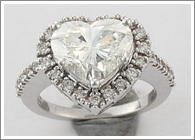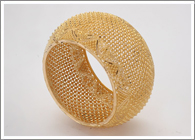Things to Know Before Buying Diamonds
4Cs Of Diamonds
Various characteristics of diamonds are
graded and categorized by the diamond industry.
Learning about diamonds is first learning about the “four Cs” of diamonds
which are considered the most important grades and categories:
- Cut
- Clarity
- Color
- Carat weight
These are the criteria jewelers use when grading diamonds, and they’re the ones you’ll need to understand to
buy the right diamond for you.Cut
Cut is probably the most important, and most challenging, of the four Cs to understand. The brilliance of a diamond depends heavily on its cut.
ClarityMost diamonds contain some inner flaws, or inclusions, that occur during the formation process. The visibility, number and size of these inclusions determine what is called the clarity of a diamond. Diamonds that are clear create more brilliance, and thus are more highly prized, and priced.
ColorColorless diamonds are the most desirable since they allow the most refraction of light (sparkle). Off white diamonds absorb light, inhibiting brilliance.
Carat WeightA carat is the unit of weight by which a diamond is measured. Because large diamonds are found less commonly than small diamonds, the price of a diamond rises exponentionaly to its size. Read this guide to get a better understanding of what a carat is and how it affects the appearance of a diamond.
Author Archives: jj_admin
Tips to Maintain your Jewelry
Tips to Maintain your Jewelry
Always:
• Apply lotion, cosmetics, hairspray and perfume before dressing in jewelry.
• When undressing, wipe each piece with a clean soft cloth to remove oils and perspiration.
• Store in a fabric-lined box, separately or individually-wrapped in tissue to prevent
scratches.Never:
• Never wear jewelry when doing physical work such as housekeeping, gardening or
exercise.• Never expose jewelry to household cleaning products.
• Never expose jewelry to chlorine swimming pools or hot tubs.
Tips for Cleaning:
• Follow the instructions appearing on the label or box.
• Clean in a secure location, not the rim of a sink where a piece may slip down
the drain.• Use only a soft brush, never sharp or hard objects, to remove dirt or particles.
• Clean your jewelry often; lotions, soaps and skin oils alter the optical properties
of diamonds and gemstones, causing them to look dull.• Seriously soiled jewelry should be cleaned professionally.
– Clean diamond jewelry with a soft brush dipped in warm water and mild detergent;
rinse under running water.– Never expose pearl jewelry to chemicals or solvents and store each piece in a
soft bag.– Don’t expose colored gemstones to chemicals, solvents or ultrasonics without
knowing their specific cleaning requirements.
Tips for Long Life:
• Keep your Laboratory Reports in a safe location, separate from jewelry pieces,
for security.• Have your jewelry cleaned and checked by a professional for worn mountings, loose
prongs and general condition at least once per year.• Have white gold re-plated, platinum re-polished and prongs re-tipped as necessary
to maintain original condition (generally every 24 months or so).• Have frequently-worn pearls restrung as necessary, with a knot between each pearl
to prevent loss if the string breaks.• Some colored gemstones should not be exposed to sudden temperature changes; know
your pieces and their needs.• Select daily-wear jewelry that is in harmony with your lifestyle and schedule
of activities.• Treat each piece as if it were a family heirloom, for someday it may be.










